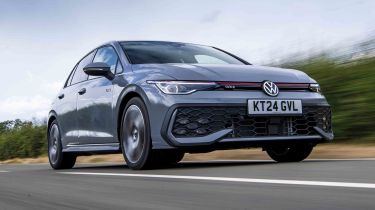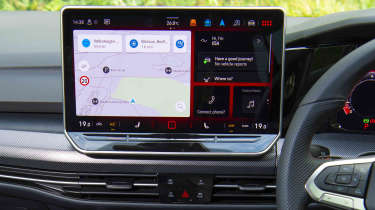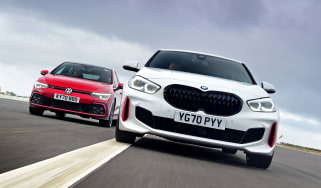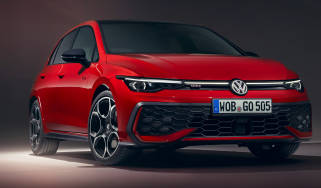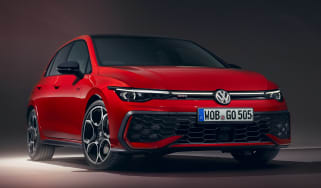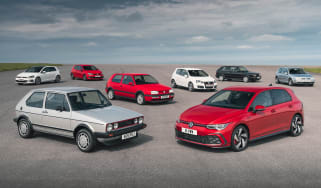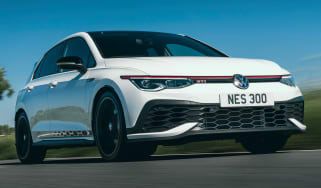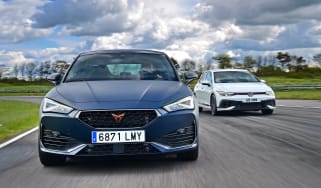Volkswagen Golf GTI review
The eighth-generation Volkswagen Golf GTI remains an impressive hot hatch all-rounder

Is the Volkswagen Golf GTI a good car?
Following a little blip in its forties, the VW Golf GTI has undergone a little self-improvement to become a more rounded overall prospect. The key appeal of the GTI throughout its near five-decade history is that it delivers excitement when you want it, but remains incredibly easy to live with every day. The latest Golf GTI delivers on that first front, while its mid-life refresh has ironed out some of the ergonomic irritations. The Volkswagen Golf R has even more pace, but the GTI is the driver’s choice in the Golf family.
| Key specs | |
| Fuel type | Petrol |
| Body style | Five-door hatchback |
| Powertrain | 2.0-litre 4cyl turbocharged petrol, front-wheel drive |
| Safety | 5-star Euro NCAP (2022) |
| Warranty | 3yrs/60,000 miles |
How much does the Volkswagen Golf GTI cost?
What can you say about the Volkswagen Golf GTI that hasn’t already been said before? After eight generations, the GTI remains the default choice if you’re after something quick and classy that can still take care of most families' everyday motoring needs. After all, few other hot hatches have come close to reaching even a fraction of the 2.3 million GTIs sold worldwide since the model was introduced in 1976.
But popularity isn’t the same as ability, and the latest Golf came under criticism when it was launched. Following on from the incredibly high standards set by the 2013-2019 Volkswagen Golf Mk7, it couldn’t quite live up to the same level, but frustratingly, it was for many reasons other than the driving experience.
Used - available now

2023 Hyundai
i30
23,040 milesManualPetrol1.0L
Cash £14,801
2021 Vauxhall
Mokka
16,283 milesAutomaticPetrol1.2L
Cash £15,795
2022 BMW
i3
34,599 milesAutomaticElectric
Cash £11,300
2019 Ford
Fiesta
55,298 milesManualPetrol1.0L
Cash £7,500Like the rest of the Mk8 Golf family, the GTI was hobbled with a string of ergonomic foibles which managed to irritate enough to detract from the entire package. Fortunately, Volkswagen has responded to the feedback, and a lot of our previous misgivings have been addressed this time around.
Despite Volkswagen heading towards an electrified future, the Mk8 Golf GTI continues to use the same 2.0-litre turbocharged four-cylinder engine as its predecessor. That’s no bad thing, though, because it proved to be a pretty complete performer, but power for the latest GTI has been increased from 242bhp to 261bhp, helping to keep the Golf competitive with a slew of talented hot hatch rivals waiting in the wings.
That increase in power means that the 0-62mph time has now dipped below the six-second mark, plus there’s a more potent GTI Clubsport version above the standard car with 296bhp and 400Nm.
But it’s the cabin where the last car was subjected to the most stick, so this is where many of the improvements have been made. The first change is right before your eyes: the return of physical buttons on the steering wheel. They take the place of the fiddly touch-sensitive controls from before, and it’s a small, but very welcome change.
There’s also a much larger 12.9-inch touchscreen infotainment system with faster processing speeds and revised software to hopefully solve the buggy system of the pre-facelift model.
The latest Golf GTI is still five-door only, but it has ditched the standard manual for a seven-speed, DSG dual-clutch automatic transmission. Pricing starts from just under £39,500 for the regular GTI, with the hotter GTI Clubsport coming in at just over £42,000. The latter puts it within reach of the Volkswagen Golf R, which starts at a little under £44,000.
As ever, the Golf GTI isn’t the cheapest hot hatch around, but you get a generous amount of standard equipment which means it doesn’t feel too spartan. Keyless entry, heated front seats, three-zone climate control, a reversing camera, adaptive cruise control and lane assist are all standard.
Engines, performance & drive
One of the Volkswagen Golf GTI’s key traits has always been its ability to offer a balanced set-up; not too hardcore to drive on a daily basis, but not too soft that it becomes dull and uninspiring out on the road.
The standard GTI has seen a power boost as part of the facelift, although that change can only really be felt if you extend the engine towards the red line, where there’s a little more eagerness than before. The rest of the time, it’s much the same; in other words, there’s plenty of flexibility low-down thanks to an unchanged peak torque of 370Nm. The engine doesn’t make the most exciting noise (the same can be said of most four-cylinder turbocharged hot hatches), so it’s down to some slightly love-or-hate exhaust crackles to add a bit of intrigue.
| Model | Power | 0-62mph | Top speed |
| Golf GTI DSG |
261 bhp | 5.9seconds | 155mph |
| Golf GTI Clubsport DSG | 296bhp | 5.6seconds | 155mph |
What is the Volkswagen Golf GTI like to drive?
In town
The Golf GTI is easy to drive during the boring daily grind, and really nails the everyday usability qualities. The brakes are easy to modulate at low speeds, and the steering is light enough when parking to make slotting it into a difficult space easier than it would be in a Honda Civic Type R.
Even with its standard suspension set-up, the Golf GTI has a more composed ride than the closest competition, though to get the best out of the GTI, we’d recommend spending an extra £720 for Adaptive Chassis Control. This introduces the electrically controlled dampers and the scope to adjust them through 15 response levels. This widens the Golf’s scope even further, giving a firm track-only setup at its most extreme, to a cossetting cruiser capable of dealing with potholes and speed bumps at its softest – all while still maintaining great body control.
On A- and B-roads
Hot hatches are more about the corners than what they’re like in town, and here the Golf GTI remains as sophisticated as before. Grip is superb on the front axle, which gives the driver huge confidence to lean heavily on the driven tyres into a corner. Yet with that agility comes a great deal of security, too.
Even with a little trail braking towards an apex, the back end doesn’t feel obliged to lose its resolve – at least away from the higher speeds of a race track – and mid corner throttle lifts cause the nose to gently tuck in rather than upset the balance too much. Some will prefer the slightly more playful feel you get from a Ford Focus ST or a Honda Civic Type-R, but there’s plenty of fun for experienced drivers while remaining accessible to more general buyers.
Those Ford and Honda drivers will feel a little more connected to the action, too, because they have access to a six-speed manual gearbox instead of the auto-only Golf. While it’s a sharp and responsive dual-clutch system, it can’t match the feeling of interaction that you get from three pedals and a gear lever.
On the motorway
As you’d expect for such a versatile hot hatch, the Golf GTI is an excellent motorway cruiser. Long distances can be covered without the smallest hint of stress, and aside from a little more road noise from those low profile tyres, the GTI is no less refined than a base model Golf.
0-62mph acceleration and top speed
Both the regular Volkswagen Golf GTI and the GTI Clubsport use the same ‘EA888’ 2.0-litre turbocharged engine. The regular GTI has gained an uplift in power from 242bhp to 261bhp, which means that the 0-62mph time dips below the six second mark; the 5.9-second time undercuts the old car by 0.4 seconds. The GTI Clubsport continues above the standard car, and with 296bhp and 400Nm, it’s also a lot more potent, with the 0-62mph sprint taking 5.6 seconds.
If you happen to find yourself on a derestricted autobahn, then the GTI and GTI Clubsport can be maxed out at a limited top speed of 155mph.
MPG, emissions & running costs
Running a powerful hot hatch like the Volkswagen Golf GTI certainly won’t deliver the low running costs of a small city car or supermini, although the GTI offers enough of a balance between performance and efficiency to make things a little more financially palatable than some hot hatches.
The WLTP combined fuel economy figure of 39.8mpg should mean you’ll be able to travel in excess of 400 miles before needing to fill up.
For those opting for the GTI Clubsport, it isn’t quite as economical as the regular GTI at 37.2mpg, but it isn’t that much thirstier that it couldn’t manage to cover a similar distance on a tank of fuel.
| Model | MPG | CO2 | Insurance group |
| Golf GTI DSG | 39.8mpg | 162g/km | 31E |
| Golf GTI Clubsport DSG | 37.2mpg | 171g/km | 31E |
Tax
Provided you avoid specifying some expensive options, the regular Golf GTI sneaks under the £40,000 threshold, which would result in an additional surcharge over the standard yearly VED tax rate. The GTI Clubsport falls foul of this, meaning you’ll need to pay an additional fee from the second year the vehicle is taxed, up until it is six years old.
Company car drivers are unlikely to choose either the GTI or GTI Clubsport as a company car due to high emissions. If you want a hot hatch as your company car but need something with lower emissions, then the Cupra Leon is available in plug-in hybrid form and will be much more affordable to run for those paying Benefit-in-Kind (BiK) company car tax.
Insurance groups
The Golf GTI is a desirable performance hatchback, but it sits in a reasonable group 31 for insurance. However, premiums have been rising across the board over the last few years, so you may wish to look at an indicative quote before committing to a purchase.
The more affordable Ford Focus ST sits in group 27, while the bonkers-looking Honda Civic Type R is in group 43.
Depreciation
Strong demand and the enduring smart sophistication of the Golf GTI brand means that residual values have generally stayed pretty strong. Our data predicts that all Mk8.5 versions should hold onto around 43 per cent of its original value after a typical three-year/36,000-mile ownership period.
This figure is a little better than the Skoda Octavia vRS, which is predicted to only be worth 40 per cent over the same period, and on par with the Ford Focus ST (41 to 43 per cent), but lags behind the Honda Civic Type R which should retain around 57 per cent over the same period.
To get an accurate valuation for a specific model, check out our free car valuation tool...
Interior, design & technology
Sticking with tradition, the latest Volkswagen Golf GTI takes a familiar, evolutionary approach to its overall design, so don’t expect the flamboyant wings and grilles you’ll find on the more aggressive-looking Honda Civic Type R.
On the styling front, there wasn’t much to complain about before, so not much has changed. The headlights have been upgraded to Matrix LED technology, which offers 15 per cent more range than the previous units on high beam. At the back, there are some revised tail light graphics, and in between there are some new wheel design options, while the GTI badge on the side, previously a fairly small graphic behind the front wheel arch, has been replaced with much larger lettering on the door.
What is the Volkswagen Golf like inside?
It was the cabin that came under fire most strongly when the Mk8 arrived, and it’s here where Volkswagen has tried to do what it can to improve things for the Mk8.5. Many found that the touch-sensitive controls were fiddly to use, which has seen some ditched altogether for the refresh. For example, the steering wheel has reverted back to physical buttons on its spokes, and they’re far more intuitive to use than the previous touch-sensitive set-up.
Some haven’t disappeared, however. The main volume control is still an awkward slider below the touchscreen, although at least it’s backlit now so it can be used in the dark. It’s a little more responsive than before, and now that the driver has access to proper volume-control buttons on the steering wheel, it’s less of a negative than it was previously. However, this slider, along with the ones on either side for the dual-zone temperature controls, are still positioned where you are likely to rest your hand when using the main touchscreen.
What is the interior quality like?
While the interior of the Golf GTI is far less cluttered than before, we’re still not entirely sold on the quality of the finish despite the refresh. There are still enough subtle red highlights that are unique to the GTI, along with the ambient interior lighting and bespoke GTI graphics to the digital instrument cluster to let you know you’re in something more than a run-of-the-mill Golf.
However, the interior lacks the details of the Civic Type R, with its steering wheel trimmed in Alcantara, its grippy lightweight sports front seats, and its genuine aluminium gear lever.
Sat-nav, stereo and infotainment
The GTI’s infotainment system is largely the same as the regular Golf, which means you get the larger 12.9-inch Discover touchscreen system that takes up prominent residence on top of the dashboard. There’s also an additional 10.25-inch digital instrument cluster called Virtual Cockpit as used on the regular Golf but with bespoke GTI graphics.
Compared with what went before, the revised infotainment screen has faster loading times, a simpler menu layout, plus the additional screen real estate allows for some functions to be on permanent display - such as the climate controls. We’d still prefer to have some physical controls, but that’s a big improvement over what went before, and allows for quick adjustments to be made withough having to delve into a submenu.
If you don’t fancy utilising the onboard navigation system, there’s always Apple CarPlay and Android Auto connectivity that’ll enable you to run navigation and music streaming apps from your phone. Speaking of audio, a six-speaker audio system with a DAB radio is standard, but this can be upgraded to a 480-watt, nine-speaker Harman Kardon sound system for a reasonable £600.
Boot space, comfort & practicality
The Volkswagen Golf GTI offers an appealing blend of performance and practicality - all wrapped up in a sophisticated package. Three-door models are no longer available, which will please those you’ll ask to travel in the rear seats, while overall cabin space is a little bigger than in the previous model. Unlike the quicker Volkswagen Golf R, you can’t get either the GTI or GTI Clubsport in a more practical estate car bodystyle.
The GTI includes plenty of useful touches that make driving, either on a busy urban route or a faster motorway journey, a little easier. Front and rear parking sensors are standard, along with automatic headlights and wipers, while on-board tech includes integrated sat-nav, adaptive cruise control and a host of driver assistance safety features.
| Dimensions | |
|---|---|
| Length | 4,289mm (4,292mm GTI Clubsport) |
| Width | 1,789mm |
| Height | 1,471mm (1,456mm GTI Clubsport) |
| Number of seats | 5 |
| Boot space | 374-1,237 litres |
Dimensions and size
The Mk8 Golf GTI measures 4287mm in length, 1,789mm wide, and 1,471mm in height. In comparison, the Ford Focus ST leaves a larger footprint, being 4,388mm in length, 1,825mm wide and 1,459mm in height.
How practical is the Volkswagen Golf?
Seats & space in the front
Much like the regular Golf, the Golf GTI has a great driving position that’s a pleasant place to sit even on longer journeys, but the standard front sports seats trimmed in the iconic Tornado Red cloth get big side bolsters for more support during cornering. There’s a wide amount of adjustment in both the front seat and the steering wheel, making it easy for most people to get comfortable. If you want electric front seats with driver’s side memory, you can get that as part of the Vienna leather option for a pricey £2,000.
There’s a large glovebox and sizable front door bins that are capable of handling a big water bottle. The latter is also carpeted to prevent items from rattling around while you’re driving. A wireless charging spot for your phone is provided as standard, and it’s angled forward to stop your phone from sliding out.
Seats & space in the back
As far as space in the back goes, the Golf GTI provides the same amount of space in the back as the regular Golf, complete with small storage pockets on the back of the front seats for placing small items, such as a smartphone.
It is possible to squeeze three people in the back of the Golf GTI, although a Ford Focus ST would be a little better in this regard thanks to a wider and flatter centre seat, and a smaller central tunnel that allows for more foot space. If you’re after even more rear leg room and extra space in general, the Skoda Octavia vRS might be a better option.
For anyone transporting children in car seats, a pair of ISOFIX child seat mounting points are provided on the outer positions of the rear bench seat, and there’s even one for the front passenger seat. The hooks in the back are hidden behind some easily removable plastic tabs.
Boot space
The GTI has a 374-litre boot which offers reasonable load space, but is outshone by both the 378-litre capacity Focus ST and 420-litre Honda Civic Type R. If you’ve decided on a hot hatch but don’t want to compromise on practicality, then the 600-litre boot of the Octavia vRS should provide all the space you need.
Towing
Surprisingly, the Golf GTI is rated to tow a maximum of 1,600kg, and a towbar can be fitted for just shy of £800.
Reliability & safety
According to the 2024 Driver Power customer satisfaction, the Volkswagen Golf came last in the best cars to own category, while the VW brand was down in 29th place out of 32 manufacturers - only one place above Ford in 30th place. A number of the issues owners had surrounded the infotainment system, so hopefully the improvements made as part of its mid-life facelift will result in an uplift in future surveys.
Euro NCAP reassessed the Golf in 2022 under more rigorous criteria than its previous 2019 result to check if its five-star rating still applied. The independent safety organisation has ruled that the Golf (along with the GTI variant) still has a maximum five-star rating, although the Honda Civic that was tested under the same criteria in 2022 did better in the adult, vulnerable road user and safety assistance categories.
Safety kit onboard the Golf GTI is excellent. In the unfortunate event of a collision, there are front, side and curtain airbag systems in place to help prevent injury, while VW’s automatic post-collision braking function brings the vehicle to a stop to try and avert a secondary impact.
Other driver assistance features include driver fatigue detection and Lane Assist with Road Edge Recognition, along with a Travel Assist system, which utilises camera and radar sensors to allow partially assisted driving, as long as the driver keeps their hands in contact with the steering wheel. The Side Assist and Rear traffic alert use radar technology to monitor approaching vehicles.
The Emergency Assist function intervenes if it detects no driver input: if the driver has no contact with the capacitive touch-sensitive steering wheel for 10 seconds, then the system activates visual and audible warnings along with a braking jolt. If there is still no response, the hazard lights are activated and the vehicle is automatically slowed and steered into the left-hand lane, bringing it to a controlled stop - traffic behind permitting.
| Key standard safety features | Euro NCAP safety ratings |
|
Warranty
Volkswagen offers the Golf with an industry standard three-year/60,000-mile warranty, with an option to extend the cover at extra cost. VW does offer extended cover for extra cost, though.
Servicing
Customers are offered a choice of how their Golf GTI is maintained, with fixed and flexible servicing options available. These relate to mileage covered, driving style and whether the vehicle is regularly producing high engine loading due to activities such as frequent hill climbs, driving with the vehicle fully loaded or towing.
Volkswagen Golf GTI alternatives
Despite a number of hot hatches disappearing from price lists, you can still find a respectable representation of fast metal that doesn’t compromise on practicality. There’s the closely related Cupra Leon, the well-priced Ford Focus ST, or the riotous Toyota GR Yaris - although that latter rival isn’t anywhere near as practical as the Golf GTI.
The more potent GTI Clubsport fits more in line with quicker hot hatches like the Audi S3 Quattro, BMW M135i xDrive, and Mercedes AMG A 35 4Matic. The Clubsport is cheaper than the Honda Civic Type R, although perhaps not quite as exciting. For those wanting even more power, there’s also the 328bhp, four-wheel-drive Volkswagen Golf R, although it comes at a premium over the GTI Clubsport.

